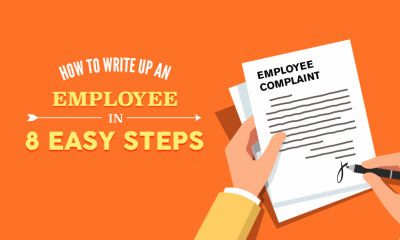How to Write up an Employee - 4 Easy Steps to Follow

posted:4 years agobyMarry JoJoin Work Life
A thing that no HR likes to do is to draft a write up of an employee. However, when things are getting out of hand, then putting employees back on track is possible through a warning letter. Today, in this article, I’m going to explain some simple processes that can transform a challenging task into an easier one.
What to Know Before creating a Write up for an Employee?
You must have a good reason to write a warning letter. And the reason shouldn’t be any personal sort. In-office politics, some managers try to show their power through warning letters. If you do this, then you are going to regret it later.
Usually, when an employee fails to follow company protocols and policies, which he agreed upon during his hiring time, then it’s when you can go and give him a warning letter.
Commonly, an HR department creates a write up for the following reasons:
- Insubordination
- Poor performance
- On account of unpunctuality or tardy
- Bad attitude
- Breaking the rules and the company’s policy
- Not following work ethics
Keep in mind that a write up is a formal document, and you can go for it when an employee keeps doing the same things over and over again. If an employee misbehaved only once and later, he changed, then you can’t report this action.
However, when an employee is a part of workplace bullying, and he keeps following the same route despite your multiple warnings, you can take action against him.
How to Write up an Employee in Four Simple Steps
Here are some steps you should follow before sending a written warning to your employees.
Step No.1 Document Everything
You need proof and documents against an employee’s behavior. Create an employee file and add all the materials that can show him what he is doing.
Is he coming late to work every day?
-
Get help from the employee attendance file.
-
Keep an eye on his arrival and departure date and time.
-
Note it all down in a separate file.
Learns way to handle tardy employee
Is he misbehaving with you and other coworkers? You need to write a statement that describes the whole situation and all the words or statements made by him against you and coworkers. You can add a witness statement from another employee as proof of his wrongful attitude or behavior.
Step No.2 Create a Write up for an Employee
Once you have all the proof explaining the reasons behind his behavior or actions, then you can create a short write up in which you will explain everything. You need to tell him.
Purpose of write up: Why are you writing this letter?
The action he should take: Even if it’s a warning letter, you need to keep your tone polite and professional. If he is showing reduced performance, tell him how he can improve his performance and how you are going to help him.
An Action You will Take: Write clearly that if he fails to comply with the company’s policies, then you are going to terminate it. Know how to terminate an employee, “The Right Way.”
Know the best ways to deal with difficult employee
In simple words, in a write up for your employee, you should tell him the main reason for the warning letter, what he can do to get out of the danger zone. In case he still doesn’t care and doesn’t abide by the rule, then you have full right to fire him.
Step No.3 Schedule a Meeting
You don’t just have to send him a warning letter through email. You need to meet him in person and tell him all about it. You will repeat the same things in the meeting but keep your tone encouraging and professional. Don’t be disrespectful or threatening in any way.
When you send a write up to your employee, then you need to keep a copy in your office records as well. This document will work as proof that you have warned an employee lawfully before terminating him.
Step No.4 Follow up
Typically, when an employee gets a warning message, then he gets alert and tries to make improvements in his action, performance, and behavior. However, we can’t directly skip the odds that he won’t care and repeat the same set of patterns and routines.
In that case, you need to send him a follow-up message to know what he is thinking and what his game plan is to deal with this warning letter. Again keep a proper record of this follow-up message. It’s good to send it after a week.
Seven days is enough time to process and ponder warning letters from an employer.
Wrap up
I have explained every single detail related to the subject “How to write up an Employee.” One last thing I should clear is that don’t write a warning letter when you are angry or in a bad mood as you won’t think objectively. You can’t make this matter personal. Always keep the company’s interests and policies first. It’s what makes you a good HR Manager.
Have something to add? Feel free to share with me.
